Widgets
Editors
The following sub-sections enumerate the currently defined instances of shui:Editor from the SHACL UI namespace.
Property shapes can explicitly specify the preferred editor for its values using shui:editor.
If no such value has been specified, the system should pick a suitable default viewer based on the
scoring system outlined for each widget.
shui:AutoCompleteEditor
Score:
- 1 if the value is an IRI.
- 0 otherwise.
Rendering:
An auto-complete field to enter the label of instances of the class specified for the property.
For example, if the sh:class of the property is ex:Country and the user starts
typing "Nig", then "Niger" and "Nigeria" would show up as possible choices.

ex:Person-bornIn a sh:PropertyShape ; sh:path ex:bornIn ; sh:class ex:Country ; ...
Implementations may want to also support the combination of sh:class with sh:node
constraints to further narrow the set of valid values.
In this case, the component would filter out any instances of the class that do not conform to the specified node shape.
In the following example, the auto-complete would only show countries that have true as their value
for ex:sovereign.
ex:Person-bornIn a sh:PropertyShape ; sh:path ex:bornIn ; sh:class ex:Country ; sh:node [ sh:property [ sh:path ex:sovereign ; sh:hasValue true ; ] ] ; ...
shui:BlankNodeEditor
Score:
- 1 for blank nodes.
- 0 otherwise.
Rendering: A read-only editor that displays the blank node, similar to shui:BlankNodeViewer, yet allows the surrounding user interface to at least provide a delete button.
shui:BooleanSelectEditor
Score:
- 10 for
xsd:booleanliterals. - 0 for non-literals and when there is a
sh:datatypeconstraint. nullfor properties allowing literals without specifying a particular datatype.
Rendering:
A select box with values true and false.
Also displays the current value (such as "1"^^xsd:boolean), but only allows to switch to true or false.

ex:Person-married a sh:PropertyShape ; sh:path ex:married ; sh:datatype xsd:boolean ; ...
shui:DatePickerEditor
Score:
- 10 for
xsd:dateliterals. - 5 if the property has
sh:datatype xsd:date. - 0 otherwise.
Rendering: A calendar-like date picker.
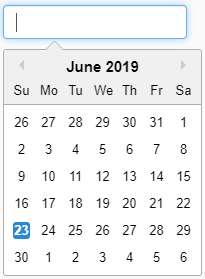
ex:Person-dateOfBirth a sh:PropertyShape ; sh:path ex:dateOfBirth ; sh:datatype xsd:date ; ...
shui:DateTimePickerEditor
Score:
- 10 for
xsd:dateTimeliterals. - 5 if the property has
sh:datatype xsd:dateTime. - 0 otherwise.
Rendering: A calendar-like date picker including a time selector.
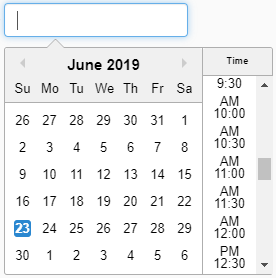
ex:Customer-lastVisitTime a sh:PropertyShape ; sh:path ex:lastVisitTime ; sh:datatype xsd:dateTime ; ...
shui:DetailsEditor
Score:
nullfor non-literals, i.e., it can be selected manually viashui:editor.- 0 otherwise.
Rendering:
Typically rendering as a nested form, using the properties defined by the sh:node or sh:class (in that order)
of the property as fields.
Alternative renderings are possible, such as opening the resource in a separate dialog.
This is particularly useful for some types of blank nodes that only make sense to be edited in the context of their parent resource.
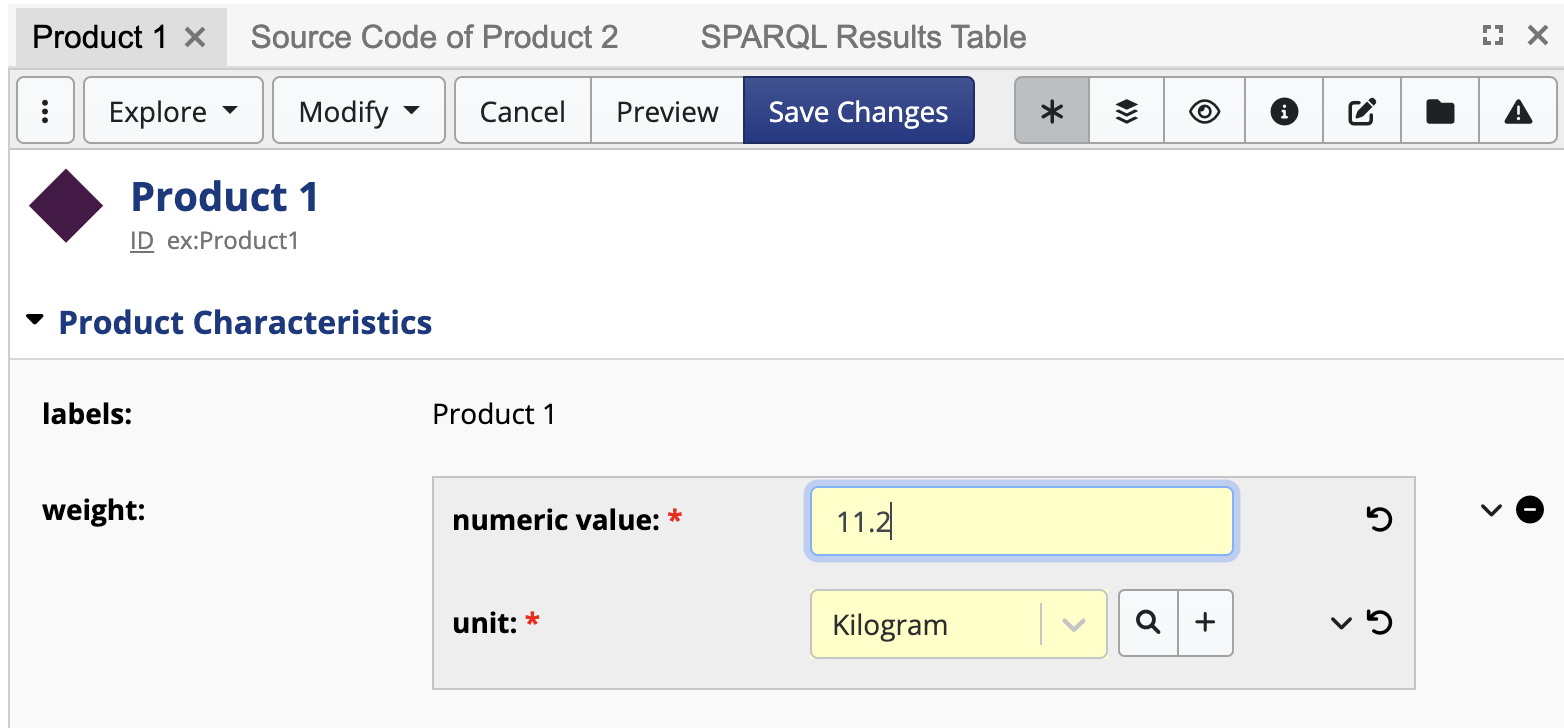
ex:Product a owl:Class ; a sh:NodeShape ; rdfs:label "Product" ; rdfs:subClassOf owl:Thing ; sh:property ex:Product-weight . ex:Product-weight a sh:PropertyShape ; sh:path ex:weight ; shui:editor shui:DetailsEditor ; shui:viewer shui:DetailsViewer ; sh:description "A blank node with a numeric field and a unit which is one of the QUDT mass units." ; sh:maxCount 1 ; sh:name "weight" ; sh:node ex:ValueWithWeight ; sh:nodeKind sh:BlankNode . ex:ValueWithWeight a sh:NodeShape ; rdfs:label "Value with weight" ; sh:property ex:ValueWithWeight-numericValue ; sh:property ex:ValueWithWeight-unit . ex:ValueWithWeight-numericValue a sh:PropertyShape ; sh:path ex:numericValue ; sh:datatype xsd:decimal ; sh:maxCount 1 ; sh:minCount 1 ; sh:name "numeric value" . ex:ValueWithWeight-unit a sh:PropertyShape ; sh:path ex:unit ; sh:class <http://qudt.org/schema/qudt/Unit> ; sh:maxCount 1 ; sh:minCount 1 ; sh:name "unit" ; sh:node [ rdfs:label "Permissible values must have quantity kind Mass." ; sh:property [ sh:path <http://qudt.org/schema/qudt/hasQuantityKind> ; sh:hasValue <http://qudt.org/vocab/quantitykind/Mass> ; ] ; ] .
This widget requires that the surrounding property (ex:weight, above) declares sh:nodeKind sh:BlankNode
and also has a sh:node constraint that points at a node shape that declares the properties that shall be editable.
shui:EnumSelectEditor
Score:
- 10 if there exists a
sh:inconstraint for the same property at the current focus node. - 0 otherwise.
Rendering:
A drop-down editor for enum fields (based on the sh:in list, in that order).

ex:AustralianAddressShape-addressRegion a sh:PropertyShape ; sh:path schema:addressRegion ; sh:in ( "ACT" "NSW" "NT" "QLD" "SA" "TAS" "VIC" "WA" ) ; ...
shui:InstancesSelectEditor
Score:
nullif there exists ash:classfor the property.- 0 otherwise.
Rendering:
A drop-down editor for all instances of the target class (based on sh:class of the property).
Typically only used for classes that have few instances.
ex:Person-homeCountry a sh:PropertyShape ; sh:path ex:homeCountry ; sh:class ex:Country ; shui:editor shui:InstancesSelectEditor ; ...
shui:RichTextEditor
Score:
- 10 for
rdf:HTMLliterals. - 0 otherwise.
Rendering:
A rich text editor to enter the lexical value of a literal and a drop-down to select language.
The selected language is stored in the HTML lang attribute of the root node in the HTML DOM tree.
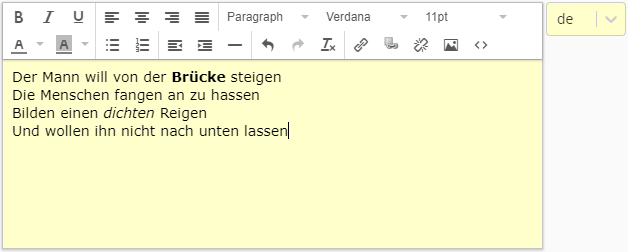
ex:Concept-definition a sh:PropertyShape ; sh:path skos:definition ; sh:datatype rdf:HTML ; ...
shui:SubClassEditor
Score:
null, i.e., this should be selected explicitly through ashui:editorstatement. However, this widget is typically only used if the property has adash:rootClassconstraint, or (at minimum) only allows classes as values.
Rendering:
This can be an auto-complete widget to select a class, a class hierarchy widget, or a combination thereof.
The permissible values are a given class or its subclasses, defaulting to rdfs:Resource.
This is typically used with dash:rootClass to allow the user to select a subclass of the given root class.
ex:Drug-impactedCell a sh:PropertyShape ; sh:path ex:impactedCell ; dash:rootClass obo:CL_0000000 ; shui:editor shui:SubClassEditor ; ...
shui:TextAreaEditor
Score:
- 0 if the property is marked
sh:singleLine true. - 20 if the value is an
xsd:stringliteral andsh:singleLine false. - 5 if the value is an
xsd:stringliteral. - 2 if the property has
xsd:stringamong the permissible datatypes. nullif the property has a custom datatype (not from xsd or rdf namespaces but for examplegeo:wktLiteral).- 0 otherwise.
Rendering: A multi-line text area to enter the value of a literal.

ex:Country-description a sh:PropertyShape ; sh:path ex:description ; sh:datatype xsd:string ; sh:singleLine false ; ...
shui:TextAreaWithLangEditor
Score:
- 0 if the property is marked
sh:singleLine true. - 15 if the value is an
rdf:langStringliteral andsh:singleLine false. - 5 if the value is an
rdf:langStringliteral or the property permits such values. - 0 otherwise.
Rendering: A multi-line text area to enter the value of a literal and a drop-down to select a language.

ex:Country-description a sh:PropertyShape ; sh:path ex:description ; sh:datatype rdf:langString ; sh:singleLine false ; ...
shui:TextFieldEditor
Score:
- 10 if the value is a literal that is neither
rdf:langStringnorxsd:boolean. - 0 otherwise.
Rendering: An input field to enter the value of a literal, without the ability to change language or datatype.

ex:Country-code a sh:PropertyShape ; sh:path ex:code ; sh:datatype xsd:string ; ...
shui:TextFieldWithLangEditor
Score:
- 11 if the value is an
rdf:langStringliteral or the property permits eitherrdf:langStringorxsd:string. - 5 if the property is not
sh:singleLine falseand permitsrdf:langStringvalues. - 0 otherwise.
Rendering:
A single-line input field to enter the value of a literal and a drop-down to select language,
which is mandatory unless xsd:string is among the permissible datatypes.

ex:Concept-prefLabel a sh:PropertyShape ; sh:path skos:prefLabel ; sh:datatype rdf:langString ; ...
shui:URIEditor
Score:
- 10 if the value is an IRI node and the property has
sh:nodeKind sh:IRIand nosh:classconstraint. nullif the value is an IRI node.- 0 otherwise.
Rendering:
An input field to enter the URI of a resource, e.g., as value of rdfs:seeAlso or to enter the URL of an image on the web.

ex:Thing-seeAlso a sh:PropertyShape ; sh:path rdfs:seeAlso ; sh:nodeKind sh:IRI ; shui:editor shui:URIEditor ; ...
Viewers
The following sub-sections enumerate the currently defined instances of shui:Viewer from the SHACL UI namespace.
A property shape can have an explicitly specified preferred viewer for its values in shui:viewer.
If no such value has been specified, the system should pick a suitable default viewer based on the
scoring system outlined for each widget.
Most viewers render a single RDF value on the screen, typically as a single widget.
Form editors offer buttons to edit individual values and to add or delete values.
However, some viewers need to take more complete control over how multiple values of a property at a focus node are rendered.
The only example of such a viewer in SHACL UI is shui:ValueTableViewer, which displays
all values of a property as an HTML table.
In those cases, the notions of generic add and delete buttons do not apply.
Such viewers are called Multi Viewers and are declared instances of shui:MultiViewer instead of shui:SingleViewer.
The equivalent classes for editors are shui:MultiEditor and shui:SingleEditor.
shui:BlankNodeViewer
Score:
- 1 for blank nodes.
- 0 for all other nodes.
Rendering: A human-readable label of the blank node. For example, if the blank node is an OWL restriction, then Manchester Syntax could be used. If the blank node is a SPIN RDF expression, then a SPARQL string could be produced. This rendering may include hyperlinks to other resources that can be reached from the blank node.
shui:DetailsViewer
Score:
- 0 for literals.
nullfor IRIs and blank nodes.
Rendering:
Shows the details of the value using its default view shape or the shape specified using sh:node,
as a nested form-like display.
An example of this can be found in the Nested Forms section.
shui:HTMLViewer
Score:
- 50 for literals with datatype
rdf:HTML. - 0 for all other values.
Rendering:
The literal parsed into HTML DOM elements.
Hyperlinks in the HTML may get redirected to select resources within the same application.
Also displays the language if the HTML has a lang attribute on its root DOM element.
shui:HyperlinkViewer
Score:
- 50 for literals with datatype
xsd:anyURI. nullforxsd:stringliterals.- 0 for all other values.
Rendering: A clickable hyperlink to the specified URI/URL.
shui:ImageViewer
Score:
50 for IRI nodes or literals that have a case-insensitive recognized image ending such as
.png, .jpg, .jpeg, .gif, or .svg.
Rendering:
The image at the given URL, using <img> in HTML.
shui:LabelViewer
Score:
- 5 if the value is an IRI.
- 0 otherwise.
Rendering:
As a hyperlink to that URI based on the display label of the resource.
The display label is typically based on the most suitable rdfs:label or
skos:prefLabel for the current user, based on their language preferences.
Also includes other ways of interacting with the URI, such as opening a nested summary display.
shui:LangStringViewer
Score:
- 10 if the value is a literal of type
rdf:langString. - 0 otherwise.
Rendering: As the text plus a language indicator (flag or language tag).
shui:LiteralViewer
Score:
- 1 if the value is a literal.
- 0 otherwise.
Rendering: The lexical form of the value.
shui:URIViewer
Score:
- 1 if the value is an IRI.
- 0 otherwise.
Rendering: As a hyperlink to that URI. Also includes other ways of interacting with the URI, such as opening a nested summary display.
shui:ValueTableViewer
This is a Multi Viewer.
Score:
null, i.e., this should be selected explicitly through ashui:editorstatement.
Rendering:
All values of the property at the focus node are rendered into a single (HTML) table that can be scrolled
and paged independently of the rest of the form.
Each value becomes one row.
The columns of the table are derived from the node shape specified using sh:node for the property,
in the order specified using sh:order.
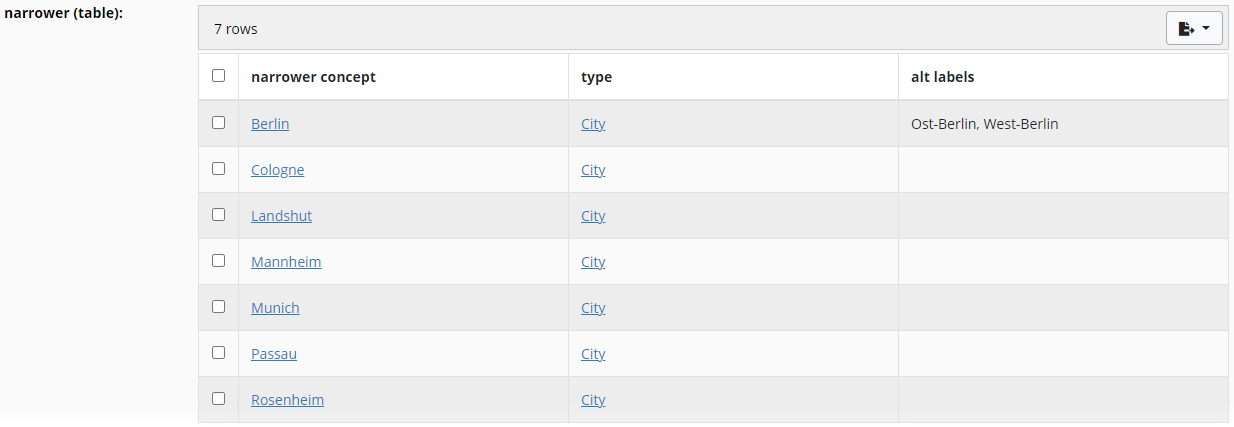
In this example, we have used a sh:values rule to infer the values of the first column.
In this case, the values are simply pointing back to the focus node of each row, using sh:this.
Note that dash:applicableToClass or sh:targetClass are needed to get this inference correctly.
skos:Concept
sh:property ex:Concept-broader-inverse .
ex:Concept-broader-inverse
a sh:PropertyShape ;
sh:path [ sh:inversePath skos:broader ] ;
sh:group skos:HierarchicalRelationships ;
sh:name "narrower (table)" ;
shui:viewer shui:ValueTableViewer ;
sh:node ex:ConceptTableShape .
ex:ConceptTableShape
a sh:NodeShape ;
dash:applicableToClass skos:Concept ;
rdfs:comment "A node shape defining the columns for a shui:ValueTableViewer." ;
rdfs:label "Concept table shape" ;
sh:property ex:ConceptTableShape-self ;
sh:property ex:ConceptTableShape-type ;
sh:property ex:ConceptTableShape-altLabel .
ex:ConceptTableShape-self
a sh:PropertyShape ;
sh:path ex:self ;
sh:description "This column is used to render the (narrower) concept itself." ;
sh:name "narrower concept" ;
sh:nodeKind sh:IRI ;
sh:order "0"^^xsd:decimal ;
sh:values sh:this .
ex:ConceptTableShape-type
a sh:PropertyShape ;
sh:path rdf:type ;
sh:description "The second column shows the type of each value." ;
sh:name "type" ;
sh:nodeKind sh:IRI ;
sh:order "1"^^xsd:decimal .
ex:ConceptTableShape-altLabel
a sh:PropertyShape ;
sh:path skos:altLabel ;
sh:description "The third column shows the alternative labels." ;
sh:name "alt labels" ;
sh:or dash:StringOrLangString ;
sh:order "2"^^xsd:decimal .